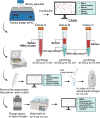Single layer centrifugation combined with brief abstinence for semen cryopreservation in a patient with hematospermia: Case report and literature review
- PMID: 40696670
- PMCID: PMC12282800
- DOI: 10.1097/MD.0000000000043272
Single layer centrifugation combined with brief abstinence for semen cryopreservation in a patient with hematospermia: Case report and literature review
Abstract
Rationale: Efficient semen preservation is important in patients with hematospermia (HS). Few reports have delineated effective methods for the removal of red blood cells (RBCs), and existing techniques have exhibited constraints that affect sperm preservation. There is a paucity of studies on semen preservation in HS patients.
Patient concerns: Prior to surgical intervention for an ejaculatory duct cyst, the patient expressed concerns regarding potential fertility impairment. Considering his intention to conceive in the near future, he opted for sperm cryopreservation in a sperm bank as a precautionary measure.
Diagnoses: We report the case of a patient who presented with HS and was diagnosed with an ejaculatory duct cyst accompanied by cyst wall calcification. Semen analysis revealed the presence of numerous RBCs in the ejaculate.
Interventions: Three semen processing techniques to eliminate blood contamination were evaluated in the laboratory. (A) Processing of the RBC lysis buffer, (B) density gradient centrifugation, and (C) single layer centrifugation (SLC). Donor semen mixed with peripheral blood was used for the experiment. Post-thawing progressive motility (%) of the sperm was evaluated using computer-assisted sperm analysis. Additionally, the patient was advised to undergo a brief period of abstinence (4 hours) to diminish the quantity of RBCs in the semen and to facilitate the freezing of additional straws.
Outcomes: The SLC can effectively remove RBCs from semen while maintaining high sperm recovery and post-thawing progressive motility. The combination of SLC and very short-term abstinence elevates the quantity of frozen sperm relative to alternative compositions. Ultimately, the patient successfully cryopreserved 5 semen straws.
Lessons: Before commencing formal treatment, it is essential to evaluate fertility preservation in individuals with HS. Employing SLC and subsequent semen collection following a brief abstinence period can mitigate the adverse effects of physical damage on sperm and avert the influence of RBC lysis on the efficacy of sperm cryopreservation. This method offers an effective strategy for autologous semen cryopreservation in a clinical setting for patients with HS.
Keywords: ejaculatory duct cyst; hematospermia; single layer centrifugation; sperm cryopreservation.
Copyright © 2025 the Author(s). Published by Wolters Kluwer Health, Inc.
Conflict of interest statement
The authors have no conflicts of interest to disclose.
Figures




References
-
- Drury RH, King B, Herzog B, Hellstrom WJG. Hematospermia etiology, diagnosis, treatment, and sexual ramifications: a narrative review. Sex Med Rev. 2022;10:669–80. - PubMed
-
- Phillips TC, Dhaliwal GK, Verstegen-Onclin KM, Verstegen JP. Efficacy of four density gradient separation media to remove erythrocytes and nonviable sperm from canine semen. Theriogenology. 2012;77:39–45. - PubMed
-
- Yazdinejad F, Heydari L, Motamed Zadeh L, Seifati SM, Agha Rahimi A. Application of erythrocyte lysing buffer (ELB) has detrimental effects on human sperm quality parameters, DNA fragmentation and chromatin structure. Andrologia. 2020;52:e13702. - PubMed
-
- Zhang Y, Cheng J, Ou J, Liu Z, Liu Y, Zang ZJ. Diagnostic performance of discontinuous density gradient centrifugation for estimating human semen quality. Andrology. 2021;9:196–203. - PubMed
Publication types
MeSH terms
Grants and funding
LinkOut - more resources
Full Text Sources

